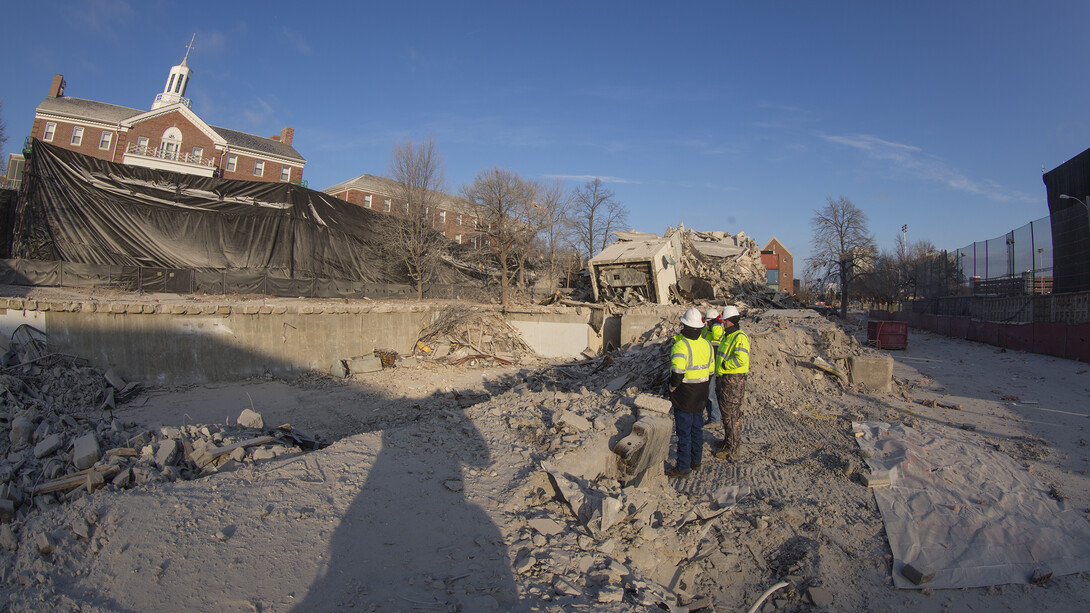
Nebraska’s fall semester, which started with the celestial spectacle of a total solar eclipse, closed with a series of bangs and a cloud of dust.
At 9 a.m. Dec. 22, Cather and Pound residence halls on the University of Nebraska–Lincoln’s City Campus were successfully razed via controlled implosion. The 13-story towers, which opened in 1963, were Nebraska’s first high-rise student housing facility.
“We’ve just witnessed the implosion of Cather and Pound halls, and from everything we know, all went as planned,” said Sue Gildersleeve, director of University Housing. “After today, cleanup of the site begins. We expect all debris to be cleared away and some additional site work to be completed by next May or June.”
Thousands of spectators lined the walls of a university parking garage at 19th and Vine streets to watch the demolition. In the minutes before the buildings fell, cheers of “Go Big Red” reverberated across the recreation fields that are between the garage and Cather/Pound towers.
“I like fireworks, so I think it’s going to be great,” said Tom Pratt, who huddled with his wife, Diane, on the fourth level of the garage about 30 minutes before the implosion.
For Husker alumna Liz Shea-McCoy, the implosion served as a teachable moment for her two grandchildren.
“We talked about the technology, planning and the safety precautions, and I wanted them to see a historical moment,” Shea-McCoy said. “They learned a new word today, implosion.”
As the buildings crumbled to the ground, McCoy’s 5-year-old grandson, Matthew Owens, repeated the new word and pointed to the rising dust plume.
“That was really cool,” Owens said.

Kelsey Linzell, a sophomore honors student and daughter to Daniel Linzell, chair and professor of civil engineering, tailgated at the garage, sharing cocoa, coffee and bagels with friends and family. She had to get up extra early and be out the door by 6 a.m. Dec. 22, as her residence hall was within the Cather-Pound evacuation zone. Kelsey’s early wake-up call was leavened by the university’s plans to convert the site into a temporary green space.
Daniel Linzell is also part of a Nebraska Engineering research team that has collected data on Cather and Pound halls as they were being prepared for implosion. The project, led by Richard Wood, assistant professor of civil engineering, has two primary goals — expand the engineering field’s understanding of how large structures react to extreme events, and use the data to refine engineering models and improve the resiliency of buildings.
Wood said the research team will begin to analyze the data during Nebraska’s spring semester. Preliminary details should be available in January.
Learn more about the research project.
Jim VanKirk of Lincoln was inside the fourth-floor vestibule of the parking garage when the implosion fired. He brought his granddaughter, 13-year-old Hanila VanKirk, with him.
Both agreed that they thought the spectacle would occur more slowly.
“Wow,” Jim VanKirk said. “It took two years to build them and two seconds for them to fall.”
After the charges finished reverberating and the dust settled, Pratt — like the majority of the crowd — seemed satisfied with the implosion.
“That was the fireworks of all fireworks,” Pratt said.
A review of nearby buildings following the implosion revealed just two cracked windows — one in Courtyards, the other in Neihardt Hall.
Grant Watson, a construction manager for the university, said conditions were ideal for the implosion with a high cloud ceiling, low humidity and a slight breeze that helped dissipate the resulting dust cloud.
“Everything went exactly as planned,” Watson said.

The next step is cleanup of the site, which will begin in earnest in early January.
Chad Lea, lead project manager and architect for the university, said the rubble will be removed by June. The rubble will be transported to the City of Lincoln’s landfill where it will be processed, with the concrete broken down and used in roadway construction.
The Cather-Pound property is designated as a general building site by the university’s master plan. No specific type of building or plans have been made for the site. The university will convert the area into a temporary green space that will include walking paths for pedestrians. It will also continue to provide access to Neihardt Residence Hall and nearby Greek houses.
“We all probably have different feelings (about the implosion),” Guildersleeve said. “I did shed a tear, I will admit, just because of the fond memories that I know so many people have of those halls and what they meant to people. Also, a sense of relief — yes, it’s over.
“We’ve done so much planning and it was able to come off this morning as planned.”
Learn more about the implosion.








